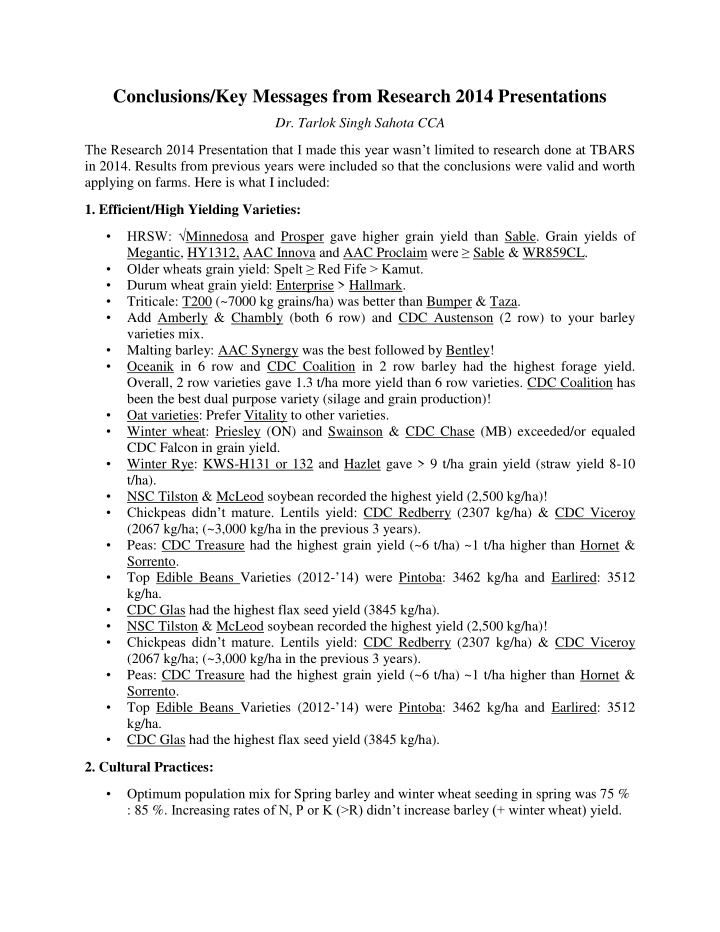



Conclusions/Key Messages from Research 2014 Presentations Dr. Tarlok Singh Sahota CCA The Research 2014 Presentation that I made this year wasn’t limited to research done at TBARS in 2014. Results from previous years were included so that the conclusions were valid and worth applying on farms. Here is what I included: 1. Efficient/High Yielding Varieties: • HRSW: √ Minnedosa and Prosper gave higher grain yield than Sable. Grain yields of Megantic, HY1312, AAC Innova and AAC Proclaim were ≥ Sable & WR859CL. • Older wheats grain yield: Spelt ≥ Red Fife > Kamut. • Durum wheat grain yield: Enterprise > Hallmark. • Triticale: T200 (~7000 kg grains/ha) was better than Bumper & Taza. • Add Amberly & Chambly (both 6 row) and CDC Austenson (2 row) to your barley varieties mix. • Malting barley: AAC Synergy was the best followed by Bentley! • Oceanik in 6 row and CDC Coalition in 2 row barley had the highest forage yield. Overall, 2 row varieties gave 1.3 t/ha more yield than 6 row varieties. CDC Coalition has been the best dual purpose variety (silage and grain production)! • Oat varieties: Prefer Vitality to other varieties. • Winter wheat: Priesley (ON) and Swainson & CDC Chase (MB) exceeded/or equaled CDC Falcon in grain yield. • Winter Rye: KWS-H131 or 132 and Hazlet gave > 9 t/ha grain yield (straw yield 8-10 t/ha). • NSC Tilston & McLeod soybean recorded the highest yield (2,500 kg/ha)! • Chickpeas didn’t mature. Lentils yield: CDC Redberry (2307 kg/ha) & CDC Viceroy (2067 kg/ha; (~3,000 kg/ha in the previous 3 years). • Peas: CDC Treasure had the highest grain yield (~6 t/ha) ~1 t/ha higher than Hornet & Sorrento. • Top Edible Beans Varieties (2012- ’14) were Pintoba: 3462 kg/ha and Earlired: 3512 kg/ha. • CDC Glas had the highest flax seed yield (3845 kg/ha). • NSC Tilston & McLeod soybean recorded the highest yield (2,500 kg/ha)! • Chickpeas didn’t mature. Lentils yield: CDC Redberry (2307 kg/ha) & CDC Viceroy (2067 kg/ha; (~3,000 kg/ha in the previous 3 years). • Peas: CDC Treasure had the highest grain yield (~6 t/ha) ~1 t/ha higher than Hornet & Sorrento. • Top Edible Beans Varieties (2012- ’14) were Pintoba: 3462 kg/ha and Earlired: 3512 kg/ha. • CDC Glas had the highest flax seed yield (3845 kg/ha). 2. Cultural Practices: • Optimum population mix for Spring barley and winter wheat seeding in spring was 75 % : 85 %. Increasing rates of N, P or K (>R) didn’t increase barley (+ winter wheat) yiel d.
• Seeding winter wheat after barley gave 1,253 kg/ha higher yield than seeding it with barley. • Intercropping flax with oats (50:50) increased forage yield by 2.4 t/ha. Intercropping flax with barley and wheat increased grain yield by 300-600 kg/ha. • Forage Yield from winter cereals at flag leaf was 2.2-2.4 t/ha with 16-17 % protein. • Intercropping berseem 100SR with oats 70SR added ~1t/ha to the forage DM yield and 2.5 t/ha to the grain yield! • Galega gave 2.63 t/ha higher yield than alfalfa in 3 years. Intercropping alfalfa, not Galega, with berseem improved yield by ~2t/ha. • Galega could be better forage legume than alfalfa both in terms of yield and protein content! • Sencor @ 925 g/ha was the best for weed control in chickpeas. 3. Nutrient Management: • Increase rate of Ammonium Sulphate (AS) application to alfalfa from 100 to 150 kg/ha. Potassium Sulphate isn’t better than AS! • Replacing 20 kg N from urea with ESN increased barley forage DM yield by 1260 kg/ha at an extra cost of ~$6/ha only. • Use N fertilizer blends containing urea, ESN and AS for grasses production and apply N @ 140 kg/ha. The combination gave 1.44 t/ha extra grass dry matter yield at an additional cost of $72.2/ha. • Fall applied 80 kg N/ha from urea and ESN (50:50) gave ~250 kg/ha extra spring wheat grain yield than spring applied urea @ 80 kg N/ha. ESN appeared to increase Zn content in spring wheat grains. These results are only from one year (2014). • Without S, K 2 O @ 140 kg/ha gave higher grasses yield than 70 kg K 2 O/ha. With 24 kg S/ha, there was no response to K beyond 70 kg K 2 O /ha (results from 2014 only). • MasterGraze corn produced 8.4 t/ha forage yield in 80 days. Urea + ESN (3:1) @ 100 kg N/ha equaled urea @ 150/or 200 kg N/ha in forage yield. • Sorghum Sudangrass yield at 150 kg N/ha was 7.2 t/ha and 7.8 t/ha at 200 kg N/ha. • Wood ash, but not lime, had some positive effect on canola seed yield (2014 results). • Canola seed yield increased linearly with N up to 120 kg/ha. Zn had some impact. Manure and S had the biggest positive impact on canola yield! • Manure increased canola seed yield more than wood ash; and S increased the canola yield more than any other nutrient (N or P or K or Zn); based on 2014 results. • Add at least one more crop between corn-wheat rotation; canola is one of the good options! Peas, edible beans and flax could be others. In the forage crops, MasterGraze corn, Sorghum Sudangrass, Galega and Sainfoin could be worth trying! The Final Word: Good Agronomic advice could add 30 % to income! (Gabrielle Ferguson in Ontario Farmer, February 3, 2009). Please note: N, P, K, S, Zn and SR stand for nitrogen, phosphorus, potassium, sulphur, zinc and seed rate, respectively. You may wish to see TBARS Annual Reports 2012- ’14; for detailed results. If there are any questions, please feel free to contact me at tarloksahota@tbaytel.net till March 31, 2015 and at Drtssahota@gmail.com after that. All the Best for Season 2015 and Always! May you have Bumper Crops!! Published in Northwest Link, March 2015, Pages 7-9.
Recommend
More recommend